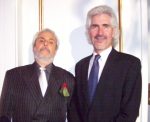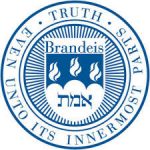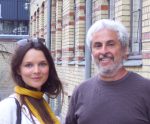In this Season of Giving, we are wrapping up this year’s #Germinder20 #PowerofPink Honoree interviews with someone who has spent a lifetime of giving back. Arne Zislin, VMD, MBA has been named the final Germinder20 Power of Pink Honoree this year. It is a fitting tribute as I turned to him for his counsel when Germinder & Associates was launched twenty years ago. He is still a mentor and a bridge to our recent coverage of international veterinary medicine. In his professional life, he is a veterinarian who combines the “Power of Three” – his experience as a practicing veterinarian, an industry veterinarian and ties to academia to give back through student development programs and more. In his personal life students from all over the world have received his mentorship and guidance. The most recent group to benefit from him is the International and Immigrant Student Services (IISS) at Johnson County Community College (JCCC). He’s pragmatic, personable, so darn smart, yet patient and kind. Oh, and you can count on him. Thank you, Arne! – Lea-Ann Germinder, Editor & Publisher

We’ve interviewed dozens of veterinarians over the years and it seems that in many cases, the desire to become a veterinarian began at an early age. What’s your story?
At first, human medicine was on my mind. I always had a strong interest in medicine and thought it would be exciting and challenging to help people who were sick transition back to health. My drive to instead become a veterinarian was not an early age fantasy but one that developed as I matured. I love and am continually impressed by animals that befriend us and provide us with companionship and insights into being humble and happy. Becoming a veterinarian enabled me to combine my fondness for animals and my interest in medicine.
Tell us about your years at the University of Pennsylvania School of Veterinary Medicine. It’s interesting that you chose the nation’s only veterinary school developed in association with a medical school and received your Veterinariae Medicinae Doctoris, or VMD degree. What was that like? Is there any particular story that stands out that convinced you that you had met your calling?
 Any veterinarian will tell you that your years in veterinary school are tough. You must learn an incredible bank of knowledge that precedes your final years in the clinic before you can graduate and truly “begin to learn” to be a practicing veterinarian.
Any veterinarian will tell you that your years in veterinary school are tough. You must learn an incredible bank of knowledge that precedes your final years in the clinic before you can graduate and truly “begin to learn” to be a practicing veterinarian.
Overall, I was very fortunate to have been in veterinary school as specialties in the profession were in their infancies and the key people who were the leaders in small animal dermatology, cardiology, and ophthalmology were at the University of Pennsylvania. My classmates and I were constantly at the footsteps of these people, they were great teachers and the excitement of being there, as new information was being developed to address the quality of life in animals was incredible.
Can you share with us how you started out practicing veterinary medicine?
After spending two years as an associate in a practice in McLean, Virginia, I became a partner in a small animal practice with hospitals in Hammonton and Vineland, New Jersey. This was a great opportunity to practice primary care veterinary medicine. Both practices were geographically on the interface between rural and suburban areas. Pets lived freely outdoors and were exposed to a multitude of infectious diseases, parasites and accidents. This was an opportunity to enhance pet owner and staff education. The established preventive care practices in these animal hospitals were secondary to treating animals that were already diseased.
In my first year in the practice, we found over 80 percent of dogs were positive for Lyme disease and treated over 50 percent of the dogs for heartworm disease. Lyme disease awareness was minimal in an area already determined to be endemic for the disease in people and only a few clients routinely tested their dogs for heartworm disease and placed them on daily preventive oral medication.
Why did you decide to leave veterinary practice and become an industry veterinarian?
We all evolve in our professions and hopefully eventually find niches that continue to excite us and keep us productive. After years of serving pet owners and their pets, I decided I was no longer excited in my daily activities in the practice. I made the decision to update my business management acumen, went back to get my MBA, and apply for a position with an animal health company. I completed the MBA, learned new skills applicable to both small animal practice and industry and applied for a technical services position with multiple companies.
I initially worked for Fort Dodge Animal Health (FDAH) and then transitioned to Boehringer Ingelheim. My friends thought I was a bit crazy, but I could not have made a better personal decision. My veterinary colleagues and I in industry have been able to contribute to new product development for the better health care of pets and education for both practitioners and pet owners. My outreach has been substantially greater than if I remained in private practice.
You spent many years at Fort Dodge Animal Health working on introducing vaccines and pharmaceutical medicines that changed veterinary medicine. A significant project was your work in Eastern Europe, including the establishment of a distributorship in the Czech Republic, which increased sales by 600 percent in four years, quite an incredible trajectory. Can you tell us about that experience?

Dr. Arne Zislin and Tomas Tink of Cymedica, Czech Republic with a member of the Hungarian scout program at the ISFM meeting in Budapest.
In the late 1990s following the acquisition of American Cyanamid by American Home Products, the parent corporation of Fort Dodge Animal Health (FDAH) at that time, many highly skilled professionals from American Cyanamid went to new companies and developed marketing relationships with Fort Dodge Animal Health products in their home countries. They needed veterinarians with technical knowledge and product experience to interface with their customers and share the competitive advantages of FDAH products.
I volunteered to work with many of these people in central Europe. I gained a quick rapport with most of the veterinarians and was eager to share both my practice experience and company knowledge to help these distributorships grow and succeed. Three to four times a year I would travel for a week to Poland, and the Czech and Slovak Republics and Hungary to assist in their launching of FDAH vaccines and pharmaceuticals. The Czech Republic relationship was particularly successful during that time.
You have seen veterinary medicine practiced in many countries in Europe. Is there a commonality that you’ve seen in how veterinary medicine is practiced across the board? Are there any unique challenges?

Dr. Arne Zislin with Dr. Mike Lappin at the ISFM Meeting in Budapest
I visited practices in central Europe and attended many international veterinary meetings throughout Europe. Today, there are many veterinarians who do the same thing in order to bring state of the art practices to their communities. Speakers at all major veterinary meetings are from veterinary universities and practices from around the world and they openly share best practices. Major veterinary organizations have a global membership today. Excellent practices throughout the world practice similarly. Most of the time the limiting factor is resources – do the veterinarians have access to equipment, products and funds and do the pet owners have the funds to optimize the delivery of healthcare to their pets?
We have a shared interest in mentorship and program development – and seeing projects through. There is one particular program that you developed for Fort Dodge Animal Health that you are most proud of. Can you tell us about it?
I am proud of developing a broad-based academic liaison program with the veterinary universities for FDAH in 2004. My goals were to improve the relationships between academia and animal health companies, provide educational resources for veterinary students beyond the scope offered to them through their normal curriculum, and provide opportunities for career development for selected residents.
By the end of 2005, we had student representatives at every veterinary college working with us to achieve our goals. Our student representatives worked internally with various club presidents in every species group and with our field veterinarians for focused student meetings.
We found that students who were totally focused in small animal medicine learned an appreciation for production medicine and visa versa. Our field veterinarians interfaced with students with whom they would meet as company veterinarians/customers in the coming years and developed a positive rapport that enhanced the possibilities of doing business later on.
Our resident scholar program garnered high-level reviews by key opinion leader academicians who were their university advisors and enabled us to gain their support for our products and occasional collaboration on phase 4 projects. The level of commitment and resources to this program yielded an incredible amount of goodwill that enabled us to function well in the marketplace.
We worked together on several vaccine issues and public education campaigns. I was coming at it from the public relations perspective, you from the scientific perspective. Your ability to distill complex scientific issues down to pragmatic and practical language was a lifesaver. Can you give us any insights into your methodology?
 I must say that I owe my ability to think in an objective and critical manner to my undergraduate education at Brandeis University. I do this with everything. I think it is essential to always question data and the methodology in which it was derived and ask the question as to whether or not it is meaningful to me as a practicing veterinarian for the welfare of my patient. If it is, then communicating the information to your colleagues and client is essential before you implement anything.
I must say that I owe my ability to think in an objective and critical manner to my undergraduate education at Brandeis University. I do this with everything. I think it is essential to always question data and the methodology in which it was derived and ask the question as to whether or not it is meaningful to me as a practicing veterinarian for the welfare of my patient. If it is, then communicating the information to your colleagues and client is essential before you implement anything.
I always ask the question “Does this make sense to me”, and if yes, I ask my colleagues “Does this make sense to you”? It is essential to communicate science in the same manner you communicate more simplistic things in order to gain mutual understanding and compliance in medicine. Otherwise, you, as a doctor, are unsuccessful.
What are some tips you can give to veterinary teams that need to communicate important messages regarding vaccines and pet wellness?
Taking the time initially with new clients to better understand their knowledge of animal health might enable the clinical staff to efficiently focus on their communications with each pet’s family.
It can be difficult today to provide the scientific foundation to pet owners before sharing specific information related to a pets’ condition, but using a “faster shorter format” might be insufficient because pet owners still want to understand what is best for their pet.
We are being forcibly conditioned to multi-tasking and sometimes not doing our best in the end. Vaccination and pet wellness programs are extremely cost-effective so they should also be prioritized.
We worked together when the vaccine protocols were changing. Veterinary professionals and the public alike were debating what was the right path. What was the key to working through some of those sensitive issues with your colleagues and communicating with the public? Do those apply today?
Listening to each other is number one and then working to find the common ground. Veterinary medicine still has limited resources for research compared to human medicine. For instance, studies that focus on duration of immunity (how long a vaccine protects a pet) for specific diseases using specific vaccine formulations require large populations of animals and are very impractical to do. So, discussions were mainly based on empirical data with small groups of animals.

Healthy Cats For Life was just one of many programs developed by Germinder + Associates that we worked on together with Dr. Zislin.
This is probably not predictive of what would happen in large populations of animals living under different conditions. This is why there were many contentious discussions. The situation has not changed. Fortunately, we are doing the right thing, since infectious diseases in well cared for pets are uncommon. Many veterinary students graduate from school without seeing many of the diseases, which we control through preventive health programs.
You have shown great dedication to your work, but also to your profession. You are a member of the American Veterinary Medical Association (AVMA), the Kansas City Veterinary Medical Association (KCVMA), the American Association of Feline Practitioners (AAFP) and the International Cat Community (ICC) and the International Society of Feline Medicine. What does joining those organizations give you and what can you say to young veterinarians about why they should join?
All young veterinarians should join their local and national veterinary organizations to be a part of a network which will serve as a foundation for important medical information and professional contacts throughout their careers. If they have a special interest, and mine is feline medicine, they should join the special interest group and plan on attending organizational meetings for CE. It is easy in practice to sequester yourself in your own practice with your own ideas, but to be a great clinician you need to share ideas and experiences with your colleagues.
Your special area of interest is feline medicine. You were on the board of AAFP for many years, including as Treasurer and Program Chair for the World Feline Veterinary Conference in Boston. What does a specialty organization offer young practitioners and future leaders?
Specialty organizations like AAFP offer young practitioners the opportunity to excel through their unique interests and skills in their profession. As a member of a specialty organization, you have direct contact with people who are providing health care for pets like you but also may be working on research projects, be involved in practice development activities, and be experts on the speaker circuit. These other activities may be of interest to you. These colleagues can act as collaborators or mentors to increase your professional development in the specialty of your choice.
You’ve always been a big proponent of giving back your time, especially to young people. Can you tell us about some of the work you and your wife have done hosting international students and the benefits you’ve derived from that?

Dr. Zislin with Maja, a Danish Exchange Student.
We began hosting high school exchange students in 1982 and continue to host a young man from Vietnam who has completed his Master’s degree and currently works for Ernst & Young. Our “international family” consists of 15 former students, their families and children from various parts of the world. We have had five “international family reunions” both in the USA and abroad.
There have been numerous connections between these “former students”, and they make contact with each other independent of us. We have experienced visiting most of them in their home countries and enjoyed meeting their families and friends.

Dr. Zislin with Majas Father and Stepfather.
Our world is broader and we have increased our understanding of the basics of human sharing and caring by opening our home to strangers. All have had the same influence on our family and friends in the communities in which they lived over these many years. It works!

A Reunion of Dr. Zislin’s Exchange Students in Sweden.
What can you tell us about the organization you have designated your Germinder20 Power of Pink Honoree donation to go to?
My wife and I have had a special interest in facilitating cultural and educational exchange with international students beyond hosting them in our home. It has been our experience that the opportunities for the best and the brightest students from around the world to share their culture within our communities and, in turn, give us the opportunity to share our culture on a personal level provides all of us with great knowledge and mutual respect.
The International and Immigrant Student Services (IISS) at Johnson County Community College (JCCC) in the Kansas City area recruits students from around the globe. Each year students encounter issues that create an impasse to their completing their year at JCCC. The IISS Department has an emergency fund to address issues that would otherwise imperil the international student’s ability to complete their year at JCCC. I have elected to designate the Germinder20 Power of Pink Honoree donation to this fund.
Is there any other volunteer work you’d like to talk about?
My wife and I currently volunteer for a variety of Kansas City organizations: The Kauffman Center For Performing Arts, The KC Rep, People to People, American Public Square and Refugee & Immigrant Services & Empowerment (RISE), a Kansas City Public Library-sponsored program which has multiple missions, one of which is to connect immigrant populations with English language mentoring services.
Anything else you would like to add?
Thank you for this award and the opportunity to talk about my profession and the organizations I care about. Little by little we can all make a difference.
Thank you Dr. Zislin for all you have done and continue to do. Happy Holidays to you and the extended Zislin global family wherever they may be!

